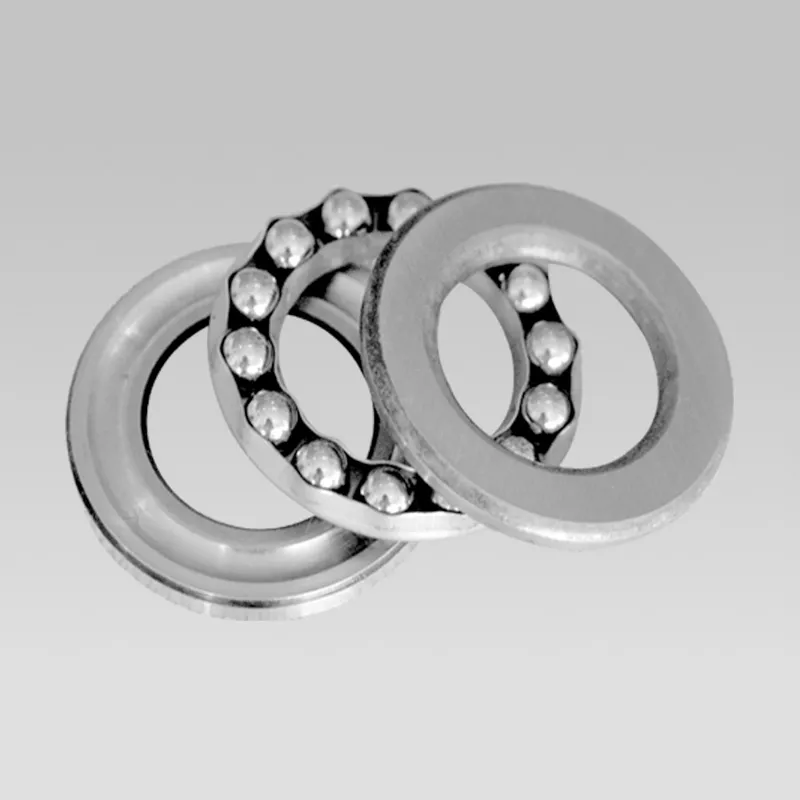
May . 26, 2025 11:08 Buyela kuluhlu
Thrust Ball Bearings: Key Features and Applications
Thrust ball bearings are specialized components designed to handle axial loads while allowing rotational motion between two parts. Unlike radial bearings, which support perpendicular forces, thrust bearings manage parallel forces, making them essential in applications like automotive transmissions, industrial machinery, and aerospace systems. Among the various types, needle thrust roller bearings, spherical thrust bearings, kwaye roller thrust bearings offer unique advantages based on load capacity, alignment flexibility, and space constraints. This article explores their features, differences, and applications to help you choose the right bearing for your needs.

Understanding Thrust Ball Bearings
Thrust ball bearings consist of two washers (raceways) and a set of balls held in a cage. They are optimized for high-speed, low-friction axial load support but are unsuitable for radial loads. Common in gearboxes, pumps, and steering systems, these bearings ensure smooth operation under unidirectional or bidirectional forces. Their compact design makes them ideal for applications with limited space, though they may require additional support for misalignment or heavy loads.
Needle Thrust Roller Bearings for High Load Capacity
Unlike standard thrust ball bearings, needle thrust roller bearings use cylindrical rollers instead of balls, enabling higher load capacities in a slim profile. These bearings excel in heavy-duty applications like automotive clutches, compressors, and construction equipment where space is restricted but axial forces are extreme. The elongated rollers distribute stress more evenly, reducing wear and extending service life. However, they are less tolerant of misalignment than spherical designs, requiring precise installation.
Spherical Thrust Bearings for Misalignment Compensation
Spherical thrust bearings feature a self-aligning design, accommodating shaft misalignment and angular errors. Their curved raceways allow the bearing to adjust dynamically, making them ideal for off-center loads in mining equipment, marine propulsion systems, and hydraulic machinery. Unlike rigid thrust ball bearings, spherical variants reduce vibration and uneven wear, enhancing durability in harsh environments. Their versatility makes them a preferred choice for applications where alignment shifts are unavoidable.
Needle Roller Thrust Bearings Outperform Roller Thrust Bearings In Specific Applications
While both roller thrust bearings and needle roller thrust bearings handle axial loads, their designs differ significantly. Standard roller thrust bearings use larger cylindrical rollers for moderate-to-high load capacities, often seen in industrial gearboxes and crane hooks. In contrast, needle roller thrust bearings employ thinner, longer rollers for extreme loads in confined spaces, such as transmission systems and aircraft controls. The choice depends on load intensity, available space, and rotational speed requirements. Needle roller thrust bearings are widely used in automotive, aerospace, and heavy machinery due to their compactness and high load-bearing efficiency. Common applications include clutch release mechanisms, planetary gear sets, and helicopter rotor assemblies. Their ability to withstand shock loads and high RPMs makes them indispensable in performance-critical systems. When paired with proper lubrication and alignment, these bearings deliver long-lasting reliability.
About Thrust Bearings FAQS
What are the advantages of thrust ball bearings over other types?
Thrust ball bearings offer low friction, high-speed capability, and compact design, making them ideal for applications like automotive steering and machine tool spindles. However, for heavier loads, roller thrust bearings or needle roller thrust bearings may be more suitable.
Can spherical thrust bearings handle radial loads?
No, spherical thrust bearings are designed exclusively for axial loads but compensate for misalignment. For combined radial and axial loads, a combination bearing or separate radial support is required.
Why choose needle roller thrust bearings for automotive applications?
Needle roller thrust bearings provide superior load capacity in minimal space, making them perfect for transmissions and clutch systems where compactness and durability are critical.
How do I know if my thrust bearing needs replacement?
Excessive noise, vibration, or increased friction during operation are common signs of wear. Regular lubrication and alignment checks can extend bearing life, but replacement is necessary once performance degrades.
Where can I buy high-quality thrust bearings?
Reputable bearing suppliers and manufacturers offer certified thrust ball bearings, needle roller thrust bearings, and other variants. Ensure the product meets industry standards for material and precision to guarantee optimal performance.
From thrust ball bearings to specialized needle roller thrust bearings, each type serves distinct purposes based on load, speed, and alignment needs. Understanding their differences ensures optimal selection for machinery, automotive, or industrial applications. Whether you need compact high-speed solutions or heavy-duty axial support, choosing the right bearing enhances efficiency and longevity. For further guidance, consult a bearing specialist to match your requirements with the ideal product.
Iindaba zamva
-
Ball Bearing 6001 – Reliable Deep Groove Bearings for Machinery & Industry
IindabaNov.24,2025
-
Comprehensive Guide to 6305 2rsr Bearings – Specs, Uses & Vendors
IindabaNov.24,2025
-
In-Depth Guide to 6003z Bearing Dimensions: Specs, Applications & Vendors
IindabaNov.23,2025
-
Understanding the 6201 Z Bearing - Specifications, Applications, & Future Trends
IindabaNov.23,2025
-
Everything You Need to Know About 6001 C3 Bearing – Specs, Uses, and Advantages
IindabaNov.22,2025
-
6208 zz Bearing – Key Technical Insights, Applications & Vendor Comparison
IindabaNov.22,2025
